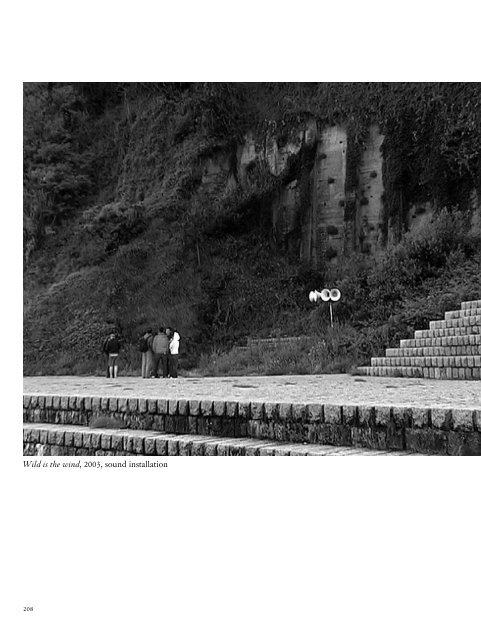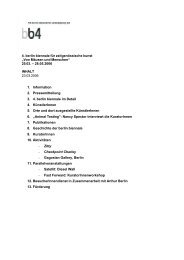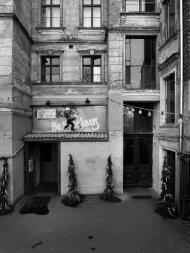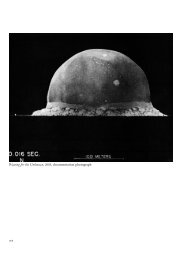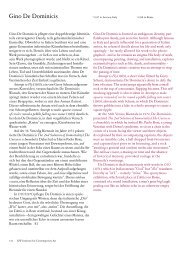Wild is the wind, 2003, sound installation - 4. Berlin Biennale
Wild is the wind, 2003, sound installation - 4. Berlin Biennale
Wild is the wind, 2003, sound installation - 4. Berlin Biennale
Sie wollen auch ein ePaper? Erhöhen Sie die Reichweite Ihrer Titel.
YUMPU macht aus Druck-PDFs automatisch weboptimierte ePaper, die Google liebt.
<strong>Wild</strong> <strong>is</strong> <strong>the</strong> <strong>wind</strong>, <strong>2003</strong>, <strong>sound</strong> <strong>installation</strong>208
Susan Philipsz * 1965 in Glasgow lebt und arbeitet lives and worksin <strong>Berlin</strong>Susan Philipsz’ Arbeiten bestehen im Wesentlichen auszwei Elementen: einem Ort und einem Sound. Letzterer<strong>is</strong>t me<strong>is</strong>t ihre eigene, aufgezeichnete und per Lautsprecherübertragene Stimme, die A-capella-Versionen bekannterPop- oder Folksongs, etwa Radioheads „Airbag“ oder„Sound of <strong>the</strong> Crowd“ von The Human League, singt. Dieunerwartete Begegnung mit dieser Stimme an öffentlichenPlätzen schafft eine unmittelbare Intimität mit demPublikum und lenkt die Aufmerksamkeit auf die gesungenenWorte sowie auf die jeweilige Umgebung. Ohne jedeinterpretierende Instrumentierung interagieren diefragilen Töne auf subtile We<strong>is</strong>e mit dem Raum und denZuhörerInnen und veranlassen diese, einen Moment langin sich zu gehen. Ob sie ein komplettes David BowieAlbum oder trag<strong>is</strong>che ir<strong>is</strong>che Volkslieder singt – Philipszbeschwört mit ihrer Stimme die anhaltende Macht vonSongs und erforscht ihre emotionale und psycholog<strong>is</strong>cheWirkung.Größere Aufmerksamkeit erlangte Philipsz erstmals mitihrer Version der „Internationale“, die an verschiedenenOrten wiedergegeben wurde, darunter eine belebte Unterführungin Ljubljana (The Internationale, 1999), wo dervon einer einzelnen Frauenstimme gesungene Schlachtrufdes Sozial<strong>is</strong>mus eine irritierende Intervention darstellte.In Guadalupe (2004) spielte sie an einer Bushaltestelle inTexas aufgezeichnete Geräusche an verschiedenen belebtenOrten in Köln ab, wo über den Geräuschen desStraßenverkehrs plötzlich eine Instrumentalfassung vonHank Williams’ „I’m So Lonesome I Could Cry“ ertönte,dann jemand, der die Melodie mitpfiff, gefolgt von einerweiblichen Stimme, die nach dem Bus nach Guadalupefragte. Mit einfachsten Mitteln erzählte die Arbeit eineGeschichte über das Bedürfn<strong>is</strong>, an ferne Orte zu re<strong>is</strong>en,und von der Melancholie und Einsamkeit des Unterwegseins.In Stay with Me (2005), erstmals aufgeführt in derMalmö Konsthall, und unlängst erneut in einer barockenKirche in Rivoli, Turin, singt Philipsz drei Songs: „I wantit now“ (Echo and <strong>the</strong> Bunnymen), „Watch with me“(Joe W<strong>is</strong>e) und „Pyramid Song“ (Radiohead). Alle drei handelnvom Hunger nach Leben, von Gefühlen wie Liebe,Verlust, Vertrauen und dem Bewusstsein vom Tode, undnehmen die ZuhörerInnen mit auf eine intime Re<strong>is</strong>e.Die Arbeit dauert insgesamt 45 Minuten und unterbrichtdas Alltagsgeschehen, indem sie Raum für etwas Grundlegenderesund Transzendentes schafft.Susan Philipsz’s works generally cons<strong>is</strong>t of two basic components:an ex<strong>is</strong>ting location paired with a <strong>sound</strong>. Thelatter <strong>is</strong> usually her own voice, singing unaccompanied acappella renditions of songs which belong to a commonrepertoire, such as pop or folk songs. Songs such as Radiohead’s“Airbag” or <strong>the</strong> Human League’s “Sound of <strong>the</strong>Crowd,” prerecorded and broadcast through speakers installedin specific sites. Her solitary voice, encounteredunexpectedly in public spaces, creates an immediate intimacywith her audience – drawing attention to <strong>the</strong> wordsshe sings and to one’s surroundings. Stripped of any interpretativeinstrumentation, her d<strong>is</strong>embodied, fragile tonessubtly interact with <strong>the</strong> space and <strong>the</strong> l<strong>is</strong>tener to provokea moment of introspection. Whe<strong>the</strong>r she sings her wayunaccompanied through <strong>the</strong> entirety of a David Bowiealbum or interprets tragic Ir<strong>is</strong>h folk songs, Philipsz’s hauntingvoice evokes <strong>the</strong> enduring power of song and exploresits emotive and psychological properties.Philipsz first gained wide attention with her renditionof <strong>the</strong> “Internationale” which was transmitted in differentlocations, including a popular underpass in Ljubljana(The Internationale, 1999), where <strong>the</strong> social<strong>is</strong>ts’ rallyingcry sung by a single female voice created an uncanny intervention.For Guadalupe (2004), she transplanted aprerecorded <strong>sound</strong> from a bus station in Texas to variousbusy public sites in Cologne where, over <strong>the</strong> no<strong>is</strong>e oftraffic, an instrumental version of Hank Williams’s “I’m SoLonesome I Could Cry” could be heard, followed bysomeone wh<strong>is</strong>tling to <strong>the</strong> melody and a female voice askingfor <strong>the</strong> bus to Guadalupe. With <strong>the</strong> simplest means, <strong>the</strong>work tells a story about <strong>the</strong> urge to travel to d<strong>is</strong>tant placesand <strong>the</strong> melancholy and loneliness of being “on <strong>the</strong>road.” In Stay with Me (2005), first performed in <strong>the</strong> MalmöKonsthall and recently re-staged in a baroque churchin Rivoli, Turin, Philipsz sings three songs: “I want it now”(Echo and <strong>the</strong> Bunnymen), “Watch with me” (Joe W<strong>is</strong>e),and “Pyramid Song” (Radiohead). The lyrics take <strong>the</strong> l<strong>is</strong>teneron an intimate journey, expressing a hunger for life,feelings of love, loss, and trust, and <strong>the</strong> awareness of death.The piece, including breaks and pauses, lasts 45 minutesand creates a rupture in everyday activity, giving way tosomething more fundamental and transcendent. ESAlter Garn<strong>is</strong>onfriedhof Old Garr<strong>is</strong>on Cemetery 209
Susan Philipsz*1965 in Glasgow Lebt und arbeitet Lives and works in <strong>Berlin</strong>EINZELAUSSTELLUNGEN SOLO EXHIBITIONS2006 Mitzuma Gallery, Tokyo– Isabella Bortolozzi Gallery, <strong>Berlin</strong>2005 Reception 3 with Robert Barry, Büro Friedrich, <strong>Berlin</strong>– Stay With Me, Malmö Konsthall, Sweden2004 Kunstverein Arnsberg e.V., GermanyGRUPPENAUSSTELLUNGEN GROUP EXHIBITIONS2007 Skulptur Projekte Münster2006 The Grand Promenade, National Museum of Contemporary Art, A<strong>the</strong>ns2005 T1 Torino Triennale Tremusei, Italy2004 Beck’s Futures 2004, Institute of Contemporary Arts, London<strong>2003</strong> Tate Triennial of Contemporary Brit<strong>is</strong>h Art <strong>2003</strong>, Tate Britain, LondonPUBLIKATIONEN PUBLICATIONS– Stay With Me, (ex. cat.) Malmö Konsthall, 2005– The Pantagruel Syndrome, T1 Torino Triennale Tremusei, (ex. cat.) T1 TurinTriennial, 2005– Days Like These, Tate Triennial, (ex. cat.) Tate Britain, London, <strong>2003</strong>– The Moderns, (ex. cat.) Castello Di Rivoli – Museo d’Arte Contemporanea,Turin, <strong>2003</strong>– Carolyn Chr<strong>is</strong>tov Biekargiev, Cream 3, London / New York:Phaidon Press, <strong>2003</strong>


